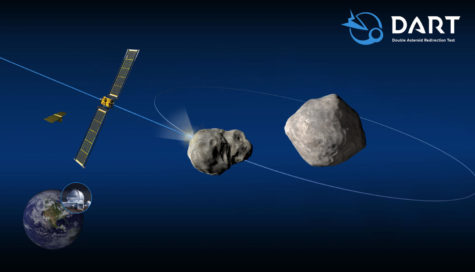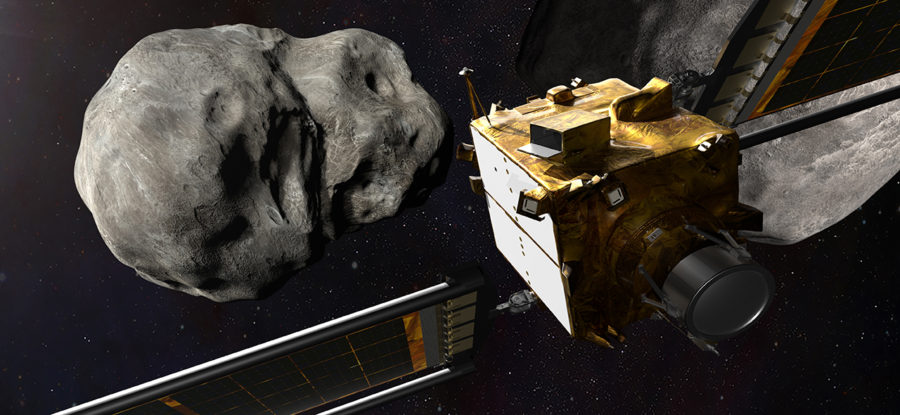NASA’s Intentional Collision in Space Could Save the Earth Tomorrow
By colliding an asteroid with a spacecraft, NASA attempts to prevent future asteroid collisions with Earth.
National Aeronautics and Space Administration, Public domain, via Wikimedia Commons
Here is a computer rendered illustration of the DART spacecraft crashing into the Dimorphos asteroid, while it is orbiting the Didymos asteroid.
NASA has done it again. Pioneering humanity’s first step into what could be the future of planetary defense, NASA successfully launched an autonomous spacecraft into an asteroid on September 26th, 2022, in order to study how forced collisions could alter the trajectory of future asteroids bound to collide with Earth.
The mission is named the Double Asteroid Redirection Test (DART, for short), the mission is meant to show just how effective impact-based asteroid redirection technology can be. The asteroid that was hit, Dimorphos, which means ‘having two forms’ in Greek, is actually the smaller part of what scientists call a “binary system.” It orbits a larger asteroid, Didymos, which stands for ‘twin’ in Greek, similar to the ways in which our moon orbits our Earth. It will take two years for Didymos and Dimorphos to cross the Sun. One point of their trajectory crosses into Earth’s orbit, but it poses no threat of collision.
Although Didymos and Dimorphos will never collide with Earth, many other asteroids could. And while a collision that could cause a mass extinction is very rare – they occur about once every ten million years – collisions from smaller asteroids could release as much energy as a nuclear bomb.
With this new technology, we now can help to prevent asteroids from colliding with the earth. By hitting an asteroid with a projectile at high speed, we can nudge its orbit. Over millions of miles, that small change in trajectory could be the difference between a near-miss and a direct hit.
Studying the practicality of this impact-based asteroid redirection technology is the true mission of DART. Dimorphos and Didymos were the perfect candidates for testing out this new technology because they impose no danger to us whatsoever. While skeptics may worry that colliding with the harmless asteroid could accidentally nudge it into our path, Dimorphos is stuck in orbit around Didymos. This means that as long as Didymos will not collide with us, Dimorphos won’t either.
Nonetheless, failure would have meant a plethora of different scenarios. For example, if the DART spacecraft were to miss completely, that would be a devastating failure for NASA and the Johns Hopkins’ Applied Physics Lab team. They would have had to revisit their calculations to see what went wrong.
But what if, theoretically, the asteroid’s orbit did not shorten? That would imply that we had an incomplete, or even incorrect, understanding of physics in space. As a result, we would have needed to rewrite laws such as the conservation of momentum and completely rediscover the world around us. Moreover, it would have caused a global outcry as impact-based asteroid redirection technology would have been removed from our arsenal against catastrophic space collisions.
Luckily, none of these scenarios played out. In the weeks following the DART mission, NASA scientists closely studied the spacecraft’s impact on Dimorphos’ orbit around Didymos. Before the crash, Dimorphos orbited around Didymos every 11 hours and 55 minutes. Now, scientists have confirmed that the orbit has shortened by 32 minutes. Dimorphos now orbits around Didymos every 11 hours and 23 minutes, with a margin of uncertainty of about plus or minus 2 minutes.
This means that DART was not only a success, but a huge one at that. NASA defined a successful mission as changing the orbit by about 73 seconds, and the collision was predicted to alter the trajectory by about 1 percent, or 7 minutes. The early results show that DART has passed the success threshold more than 25 times and exceeded expectations almost five times, implying that collision-based planetary defense might be more effective than previously thought. “DART has given us some fascinating data about both asteroid properties and the effectiveness of a kinetic impactor as a planetary defense technology,” said Nancy Chabot, who was in charge of the coordination of DART.
But why has the impact caused such astounding results? Data from LICIACube, a satellite built by the Italian Space Agency the size of a shoebox, gives us the answer. Early images from the satellite reveal sunlight reflecting off a tail of debris. So, it wasn’t just the impact that shortened the orbit of Dimorphos. Instead, the debris ejected from the asteroid acted as a propeller to push it inwards, similar to the ways in which air leaving a balloon causes it to fly forward.

Around 40 terrestrial telescopes recorded the impact of DART and the aftermath of the collision, including Goldstone, Swope Telescope at the Las Campanas Observatory in Chile, Green Bank Observatory, the Danish Telescope at the La Silla Observatory in Chile, and the Las Cumbres Observatory global telescope network facilities in Chile and South Africa. Among them, the Southern Astrophysical Research Telescope in Chile captured images of the dust tail, showing it to be longer than 10,000 kilometers. Then, two weeks after, a photograph taken by the Hubble Space Telescope showed that the tail started to split into two, something scientists still do not understand. Scientists expect the tail to disperse even more, until it has become so tenuous that it is undetectable. Of course, more research is needed to find out what will truly happen.
On top of that, for the sake of cost-effectiveness, NASA has shifted its focus on the efficiency of momentum transfer from the spacecraft to the asteroid. This will require a study on the 14,000-mile-per-hour collision with Dimorphos, and an analysis of the tons of asteroidal rock displaced by the impact. We will also need to understand the characteristics of Dimorphos, including the composition of the space rock, as well as the strength of its surface.
To do so, scientists are still collecting data from images taken by telescopes worldwide. A little less than two years from now, the European Space Agency plans to conduct a close examination of the aftermath of the DART kinetic impact. Dubbed the Hera mission, it is scheduled to launch in October of 2024. It will provide scientists with invaluable information regarding the effects of DART and asteroid geophysics in general. It plans to focus primarily on the crater left by DART’s collision and the mass of Dimorphos.
While reactions are mostly positive, the impact has also raised some outcries from the public about the necessity of expediting the development of our planetary defense systems. The Near-Earth Object (NEO) Surveyor was supposed to launch in 2026, and its designs started back in 2019. It will use two heat-sensing infrared lights to detect light and dark asteroids, which are very difficult to see. It will also use innovative technology that can detect these objects and their orbits accurately enough, in order to be found again.
However, NASA decided to cut the budget for this project from $170 million to $40 million, which delayed the launch year to 2028. The reasons are unknown, but a NASA consultant who goes by ‘doctorlinda’ speculates on her blog, “It appears that, as reflected in its fiscal 2023 budget request, NASA is prioritizing other planetary missions under way: Dragonfly to Saturn’s moon Titan, the Europa Clipper mission to Jupiter (cost has recently risen from $4.25 billion to $5 billion), and Mars sample return (which certainly will cost more – likely considerably more) than Clipper.”
Nonetheless, the budget rose to around $80 to $90 million after Congress agreed to restore some budget cuts, but it still isn’t enough. In April, an expert panel gave NASA the recommendation to proceed with the NEO Surveyor. NASA has not yet decided whether or not they would commit to launching this telescope. Some argue that for the sake of our planet, NASA needs to step up and do it now.
While we can celebrate the monumental success of the DART mission, we must not overlook the fact that any sort of planetary defense technology is useless if we cannot detect threats to our planet. DART has opened the public’s eyes to the danger of asteroid collisions. As a result, if nobody else does it, NASA needs to step up and ensure they never occur. After all, the most dangerous things are those you cannot see.
“DART has given us some fascinating data about both asteroid properties and the effectiveness of a kinetic impactor as a planetary defense technology,” said Nancy Chabot, who was in charge of the coordination of DART.
How Yat (Osmond) Chung is a News Editor and an Instagram Editor for ‘The Science Survey.' Osmond enjoys journalistic writing because it grants an audience...

